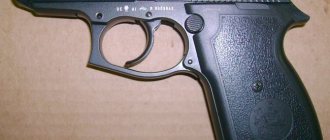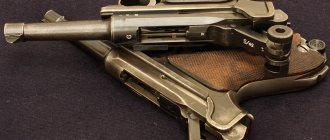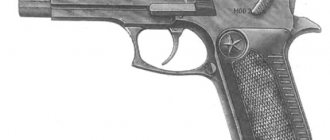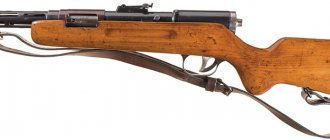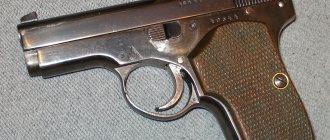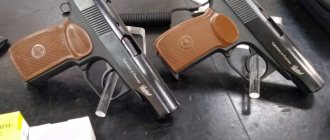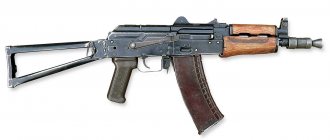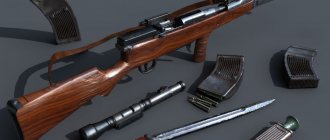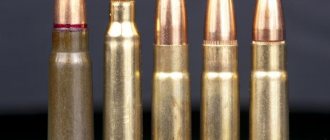This term has other meanings, see Mauser.
| Mauser | |
| Type | limited liability company (LLC)[d] |
| Base | 1872 |
| Abolished | 2004[1] |
| Reason for abolition | merger with Rheinmetall[1] |
| Successor | Rheinmetall Waffe Munition GmbH[1] |
| Founders | Peter Paul and Wilhelm Mauser |
| Location | Germany Germany, Oberndorf am Neckar |
| Industry | Defense industry |
| Products | Weapon |
| Parent company | Rheinmetall |
| Website | mauserwaffen.de |
| Mauser at Wikimedia Commons | |
Gebrüder Mauser
(German: Gebrüder Mauser) is a German company founded by brothers Peter Paul and Wilhelm Mauser to produce small arms (mainly rifles).
Content
- 1. History
- 2 Products 2.1 Rifles before 1945 2.1.1 Gewehr 71
- 2.1.2 Mauser 1889 "Belgian Mauser"
- 2.1.3 Mauser 1894 and 1895
- 2.1.4 Mauser M96 "Swedish Mauser"
- 2.1.5 Mauser 98
- 2.1.6 Mauser 98k
- 2.1.7 Volkssturmkarabiner 98 (VK.98)
- 2.1.8 Mauser T-Gewehr - 1918
- 2.1.9 Gewehr 41 (Mauser)
- 2.1.10 Sturmgewehr 45 (StG 45(M))
- 2.2.1 Mauser SP66
- 2.3.1 Zig-Zag revolver
- 2.4.1 MG 18 TuF
- 2.5.1 2 cm FlaK 30/FlaK 38
- 3.1 plant in Oberndorf am Neckar
Operating countries
- Germany Germany: a number of 6.35 mm Mauser pistols mod. 1910 and about 100 thousand more 7.65-mm Mauser pistols model 1914 were used by the German army during the First World War[3]. Basically, officers were armed with pistols of this type[4]
- Brazil Brazil: small number of Mauser 1910/12 sold to the Brazilian Navy
- Russia Russia: after testing in January 1912, by order of the Minister of War No. 186 of April 27, 1912, a 6.35 mm Mauser pistol mod. 1910 was approved as a personal weapon for army officers to be worn outside of formation, and a number more were purchased by private individuals before the outbreak of the First World War; a number of captured pistols were captured during the First World War, they were used during the First World War and the Civil War[3]
- Finland Finland: a number of 7.65 mm Mauser pistols mod. 1914 was used in Finland, they had the unofficial name " Akka-Mauser
"[5] - Germany Germany[6]
- Germany Germany: used by the police and other armed forces, as a weapon of a limited standard it entered service with the Luftwaffe, the German Navy[6] and the SS railway troops.
Also, in the 1910-1930s in Europe, the Mauser M1910 was a fairly popular example of a civilian “pocket” pistol[7].
Story
The Mauser company building complex in Oberndorf am Neckar in 1910
The arms factory in Oberndorf am Neckar was founded in 1811 by decree of King Frederick I of Württemberg.
The father of Peter Paul and Wilhelm, Franz Andreas Mauser, worked most of his life at the Royal Arms Factory in Oberndorf am Neckar. Peter Paul Mauser began working at this factory at the age of 12 and worked until he was drafted into the army at the age of 19.
On December 23, 1872, brothers Peter Paul and Wilhelm Mauser founded the company Gebrüder Wilhelm und Paul Mauser[2].
In 1872, the Mauser brothers bought the Royal Arms Factory in Oberndorf am Neckar from the Württemberg government for 200,000 South German guilders (sometimes called "florins").[3]
In 1874, after a transformation, the company became known as Gebrüder Mauser und Cie (“Mauser Brothers and Company”)[2].
In 1922, the company was transformed into Waffenfabrik Mauser AG (joint stock company Mauser Arms Factory).
Subsequently, the joint stock company Waffenfabrik Mauser also owned an arms factory in Borsigwalde, a suburb of Berlin (Mauser AG Borsigwalde).
The Mauser plant in Oberndorf am Neckar was destroyed by Allied aircraft in 1945.
After World War II, the Mauser company was founded by engineers in Oberndorf am Neckar [4].
Description of design
One of the features of these models was that the bolt stopped in the open position after the last cartridge had been fired from the magazine, which made it possible to significantly reduce reloading time and thereby significantly increase the combat characteristics of the pistol. It was enough to insert a loaded magazine, and the inserted magazine interacted with the hook, which released the bolt. In addition to the “shutter stop” function, a lever with a protrusion appeared, which, in the absence of cartridges in the magazine, locked the trigger mechanism.
In terms of structure, Mauser pistols of 1910, 1914 and 1934 have few differences, most of which are external. All models had an automatic mechanism based on the recoil of the free bolt; although the barrel does not move when firing, it can be removed quite easily during disassembly. The barrel is attached to the frame in an original way - using a long longitudinal rod. was inserted from the front, under the barrel and passed through holes in the stops made in the lower surface of the barrel. The trigger mechanism is striker-type, the manual safety was located on the left in the cutout of the cheek of the handle. The magazine release is located at the base of the pistol grip. The handle cheeks are wooden or plastic.
Despite the ease of maintenance of this pistol, it also had its drawbacks: during disassembly, small parts of the trigger mechanism were often lost. The trigger mechanism itself was sensitive to clogging; in addition, at low temperatures, pistols of the 1914 model most often misfired due to a weak mainspring.
Products
Rifles before 1945
Gewehr 71
Main article: Mauser Model 1871
In 1871, the Mauser brothers created a single-shot rifle chambered for the 11 mm cartridge, demonstrated at the Prussian Royal Rifle School in Spandau, and it was adopted as the Gewehr 1871.
Mauser 1889 "Belgian Mauser"
The company's first rifle, originally designed for a reduced caliber cartridge (7.65×53 mm) with smokeless powder. Adopted into service in Belgium, where it was produced. The following year, 1890, it was adopted into service in Turkey, and rifles for the Turkish army were produced in Germany, at the Ludwig Loewe & Companyrude and Mauser factories. Further, in 1891, the same model was adopted in Argentina. Deliveries were carried out by the Ludwig Loewe plant, and also by DWM. The same rifles were supplied to Peru, Ecuador and Colombia.
Mauser 1894 and 1895
In 1894, a repeating rifle was created, which was later adopted for service in many countries around the world (but not in Germany). There was a modification in 1895. The Model 1894 rifle was exported to Brazil and Sweden.
The Model 1895 rifle chambered in 7x57 mm was exported to Mexico, Chile, Uruguay, China, Iran and the Boer South African republics of the Transvaal Republic and the Orange Free State.
In Louis Boussenard's novel "Captain Rip-Off" (1901), which describes the events of the Second Boer War of 1899-1902, Mauser rifles are mentioned many times - apparently this is the 1895 model.
Mauser M96 "Swedish Mauser"
Main article: Swedish Mauser
In 1896, a repeating rifle chambered for 6.5x55 mm was created, intended for export to Sweden, which later became known under the unofficial name Swedish Mauser.
Mauser 98
Main article: Mauser 98
Mauser Gewehr 98 (Mauser 98; Mauser 98, G98 or Gew.98) is a rifle created in 1898, adopted by the united German army until the end of World War II and gaining a reputation as a simple and reliable weapon. According to some estimates, there are about 100 million rifles produced worldwide that can be considered variants of the Mauser 98.[5]
Mauser 98k
Main article: Mauser 98k
The rifle entered service in 1935 as the Karabiner 98k (also Kar98k or K98k, that is, officially called the “98k carbine”). In most modern sources it is called Mauser 98k. It is a modification of the Mauser 98 rifle.
Volkssturmkarabiner 98 (VK.98)
Literally translated from German - “Volkssturm carbine”. It is a greatly simplified version of the Mauser 98k rifle. The Volkssturmkarabiner 98 was produced at the end of World War II, in both single-shot and magazine versions.[6]
At the end of World War II, other German manufacturers produced Volkssturmkarabiner 1 (VK.1) and Volkssturmkarabiner 2 (VK.2) carbines, which, despite the similarity of names, have significant differences from the Volkssturmkarabiner 98.
Mauser T-Gewehr - 1918
Main article: Mauser T-Gewehr
The Mauser T-Gewehr was the first anti-tank rifle in history, developed in 1918. The cartridge used was 13.25x92 mm SR. Until the end of the First World War, it was used by the German Army on the Western Front, and after the war it was in service with some European countries.
Gewehr 41 (Mauser)
Main article: Gewehr 41
Gewehr 41 (Mauser), also known as G-41(M), is an experimental self-loading rifle chambered for 7.92x57 mm.
In 1940, the German Army Weapons Directorate put forward requirements for a new self-loading rifle for the Wehrmacht. At the end of 1941, two types of self-loading rifles began to arrive in Wehrmacht units for military testing: the G-41(M) rifle developed by Mauser and the G-41(W) rifle developed by Walther. The total production of G41(M) rifles was about 15,000 pieces[7]. In 1942, following the results of military tests, the G-41(W) rifle of the Walter system (often referred to simply as Gewehr 41 or G-41) was adopted for service.
Sturmgewehr 45 (StG 45(M))
Main article: StG 45(M)
In 1944, chambered for the intermediate cartridge 7.92×33 mm. In Russia and the USSR, weapons of this type (automatic rifle chambered for an intermediate cartridge) are usually called “automatic”. The Sturmgewehr 45 was not put into mass production due to the destruction of the Mauser plant in Oberndorf am Neckar by Allied aircraft in 1945 and the end of World War II. Subsequently, the Sturmgewehr 45 served as the prototype for the Heckler & Koch G3 rifle.
Rifles after 1945
Mauser SP66
Main article: Mauser SP66
The Mauser SP66 is a sniper rifle developed in 1976 based on the M66 Super Match sporting rifle.
Mauser 86 SR
Main article: Mauser 86 SR
The Mauser 86 SR is a police sniper rifle designed to replace the Mauser SP66. The differences from its predecessor are: a modified stock made of fiberglass or laminated plywood, equipped with an adjustable buttplate and butt comb, a detachable magazine for 9 rounds instead of a permanent one for 3, and a new bolt group.
Mauser SR 93
Main article: Mauser SR-93
The Mauser SR 93 is a sniper rifle developed in the early 1990s. Available in 7.62×51 mm NATO (.308Win), .300 Winchester Magnum, .338 Lapua Magnum caliber cartridges. Technically it is a 5 round bolt action rifle. When firing, cartridges are supplied from detachable box magazines with a capacity of 5 rounds.
Mauser M 98
Main article: Mauser M 98
Modern hunting rifle. Structurally, it is close to the Mauser 98/Mauser 98k (it differs in the shape and material of the stock, mounting for an optical sight, and external finishing). Produced from 1999 to the present (2011)[8].
Mauser M 03
Modern hunting rifle[8].
Pistols and revolvers
Revolver "Zig-Zag"
Main article: Mauser Zig-Zag
In 1878, the Zig-Zag revolver was developed [9][10]. There are modifications of 1886 and 1896.
Mauser C96 pistol
Main article: Mauser C96
In 1896, the company developed a self-loading pistol, the Mauser C96 model, which, thanks to cinema and literature, became an integral part of the image of a security officer or commissar during the Russian Civil War.
Mauser M1910 pistol
Main article: Mauser M1910
Self-loading pistol chambered for 6.35×15 mm Browning cartridge.
Mauser M1914 pistol
Main article: Mauser M1910
Self-loading pistol chambered for 7.65×17 mm, modification of the Mauser M1910 pistol.
Mauser M1934 pistol
Main article: Mauser M1910
Modification of the Mauser M1910 pistol.
Mauser HSc pistol - 1935
Main article: Mauser HSc
Self-loading pistol, adopted by the Wehrmacht in 1941.
Pistol Mauser V.7082 (Volkspistole) - 1944
Main article: Volkspistole
Created as a cheap and easy-to-manufacture pistol for the Volkssturm. Has some design similarities with Mauser HSc[6].
Submachine gun MP-3008 - 1945
Main article: MP-3008
Submachine gun, a German copy of the English STEN submachine gun (differs in a vertically located magazine; a double-row box magazine from the MP-40 submachine gun was used). Created as a cheap and easy-to-produce submachine gun for arming the Volkssturm[6][11].
Machine guns
MG 18 TuF
Main article: MG 18 TuF
Modification of the MG-08 machine gun chambered for the 13.25×92 mm SR cartridge (this cartridge was used in the Mauser T-Gewehr anti-tank rifle). The machine gun was developed by Mauser in 1918 as a means of fighting tanks and aircraft (the abbreviation TuF stands for “Tank und Flieger”, translated from German as “tank and aircraft”). It was not put into mass production.[12]
MG 81
Main article: MG-81
Aviation machine gun chambered for 7.92 x 57 mm, developed by Mauser in 1939. It is a modification of the MG 34 machine gun.
MG 42
Main article: MG 42
A single machine gun chambered for 7.92 x 57 mm, developed by Metall und Lackierwarenfabrik Johannes Grossfuss AG in 1942. Produced by several manufacturers, including Mauser.
Automatic guns
2 cm FlaK 30/FlaK 38
Main article: 2 cm FlaK 30
Automatic anti-aircraft gun of 20 mm caliber.
MG FF
Main article: MG FF cannon
20 mm caliber air cannon.
MG 151
Main article: MG 151
The aircraft cannon was produced in 15 mm (MG 151/15) and 20 mm (MG 151/20) caliber versions.
MG 213
Main article: Mauser MG 213
The aircraft cannon was produced in 20 mm (MG 213) and 30 mm (MG 213C) caliber versions.
BK 27
Main article: Mauser BK-27
Automatic cannon of 27 mm caliber. Developed in 1976.
There are ship modifications of this gun - CMN 27 GS
and
MLG 27
.
MK 30
Main article: Mauser MK 30
Automatic cannon 30 mm caliber. Developed in the early 1980s.
Options and modifications
Mauser 1910. 6.35 mm. 9 Patr.
- Mauser 1910
- model mod. 1910 caliber 6.35 mm[2] - Mauser 1910/14
- model mod. 1910/14 caliber 6.35 mm - Mauser 1914
- model mod. 1914 caliber 7.65x17 mm[2] - Mauser 1910/34
- model mod. 1934 caliber 6.35 mm. - Mauser 1914/34
- model mod. 1934 chambered for 7.65x17 mm[2]
Characteristics
| Model | Weight | Length | Barrel length | Cartridge | shop |
| Mauser 1910 | 425 | 116 mm | 78.5 mm | 6.35 mm | 9 Patr. |
| Mauser 1914 | 600 g. | 152 mm | 86 mm | 7.65 mm | 8 patr. |
| Mauser 1914/34 | 560 g | 158 mm | 86 mm | 7.65 mm | 8 patr. |
Mauser M1910 chambered for 7.65x17 mm
